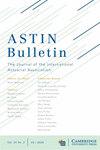OPTIMAL CONTROL OF THE DECUMULATION OF A RETIREMENT PORTFOLIO WITH VARIABLE SPENDING AND DYNAMIC ASSET ALLOCATION
IF 1.8
3区 经济学
Q2 ECONOMICS
引用次数: 1
Abstract
Abstract We extend the Annually Recalculated Virtual Annuity (ARVA) spending rule for retirement savings decumulation (Waring and Siegel (2015) Financial Analysts Journal, 71(1), 91–107) to include a cap and a floor on withdrawals. With a minimum withdrawal constraint, the ARVA strategy runs the risk of depleting the investment portfolio. We determine the dynamic asset allocation strategy which maximizes a weighted combination of expected total withdrawals (EW) and expected shortfall (ES), defined as the average of the worst 5% of the outcomes of real terminal wealth. We compare the performance of our dynamic strategy to simpler alternatives which maintain constant asset allocation weights over time accompanied by either our same modified ARVA spending rule or withdrawals that are constant over time in real terms. Tests are carried out using both a parametric model of historical asset returns as well as bootstrap resampling of historical data. Consistent with previous literature that has used different measures of reward and risk than EW and ES, we find that allowing some variability in withdrawals leads to large improvements in efficiency. However, unlike the prior literature, we also demonstrate that further significant enhancements are possible through incorporating a dynamic asset allocation strategy rather than simply keeping asset allocation weights constant throughout retirement.具有可变支出和动态资产配置的退休投资组合累积的最优控制
我们扩展了退休储蓄累积的年度重新计算虚拟年金(ARVA)支出规则(Waring和Siegel (2015) Financial Analysts Journal, 71(1), 91-107),以包括取款上限和下限。有了最小的提取约束,ARVA策略就有耗尽投资组合的风险。我们确定了动态资产配置策略,该策略最大化了预期总提款(EW)和预期缺口(ES)的加权组合,定义为实际终端财富结果中最差的5%的平均值。我们将动态策略的表现与更简单的替代方案进行比较,后者在一段时间内保持不变的资产配置权重,同时伴随着我们修改后的ARVA支出规则或按实际价值计算随时间不变的提款。使用历史资产收益的参数模型以及历史数据的自举重采样进行了测试。之前的文献使用了不同于EW和ES的奖励和风险衡量标准,与此一致的是,我们发现允许提款的一些变化会导致效率的大幅提高。然而,与先前的文献不同,我们还证明,通过纳入动态资产配置策略,而不是简单地在整个退休期间保持资产配置权重不变,进一步显著增强是可能的。
本文章由计算机程序翻译,如有差异,请以英文原文为准。
求助全文
约1分钟内获得全文
求助全文
来源期刊

ASTIN Bulletin
数学-数学跨学科应用
CiteScore
3.20
自引率
5.30%
发文量
24
审稿时长
>12 weeks
期刊介绍:
ASTIN Bulletin publishes papers that are relevant to any branch of actuarial science and insurance mathematics. Its papers are quantitative and scientific in nature, and draw on theory and methods developed in any branch of the mathematical sciences including actuarial mathematics, statistics, probability, financial mathematics and econometrics.
 求助内容:
求助内容: 应助结果提醒方式:
应助结果提醒方式:


